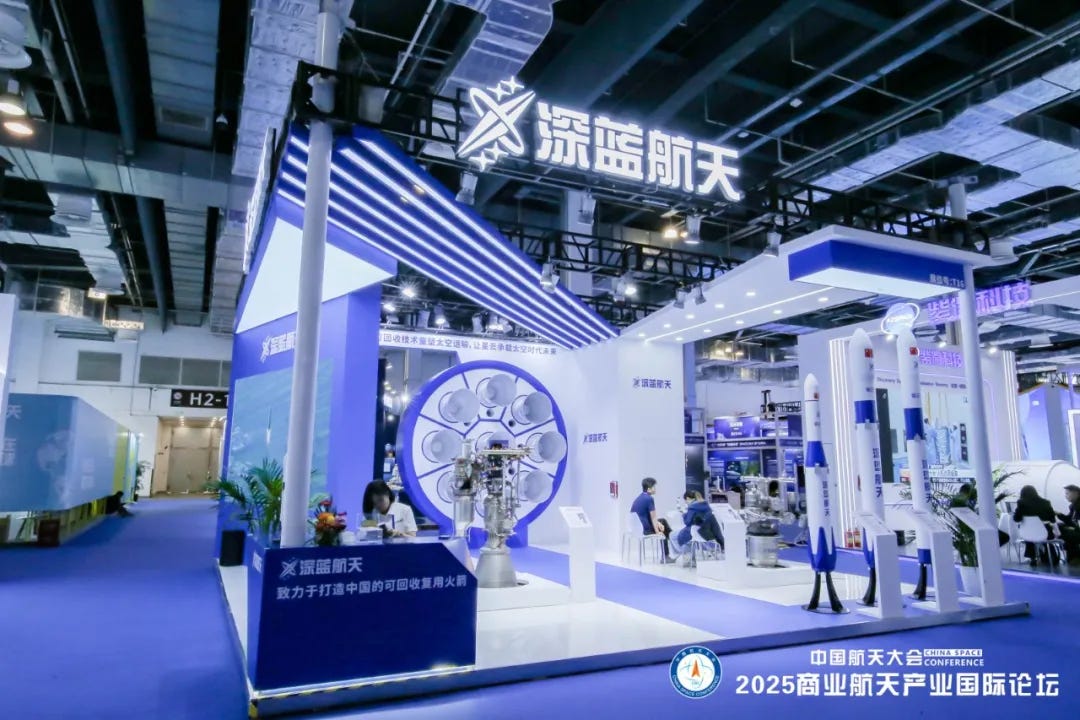10th Space Day Attended by Private Space Sector
A few commercial space companies have taken the chance to show off their rockets.
At 10th Space Day on April 24th, held at the Shanghai World Expo Exhibition and Convention Center until May 5th, a handful of China’s privately-held space enterprises provided updates on their endeavors regarding spacecraft and reusable rockets.
Deep Blue Aerospace
Deep Blue Aerospace utilized the space day to share that the first flight of Nebula-1 is on track for this year, in a configuration with a smaller payload capacity and second-stage. Following a few flights in a less capable configuration, an improved Nebula-1 will begin to fly. It was highlighted that major tests of the rocket and relevant systems had been completed this year.
Additionally, the company shared that Nebula-1B, the improved version of the rocket, will fly in 2026, while Nebula-2 will debut in either 2026 or 2027.
LandSpace
LandSpace said fairly little about its launch vehicles, Zhuque-2 and the reusable Zhuque-3, on the space day. Instead, the company has let images of hardware do the talking for them. The images are of Zhuque-3’s first-stage, TQ-12 series engines, landing legs, and test tanks.
As covered previously, Zhuque-3 is not far away from its first flight, possibly as soon as July.
Galactic Energy
Galactic Energy, operator of the Ceres and Pallas series of rockets, shared on the 10th Space Day that it has developed a new rocket-grade kerosene and liquid oxygen burning engine, the CQ-90. The CQ-90 is planned to have performance similar to SpaceX’s Merlin 1D, and has various systems based on the company’s CQ-50 engine.
Additionally, Galactic Energy added that the CQ-50 engine had recently performed a total of three hundred seconds at a newly upgraded test stand. A total of eight CQ-50 engines will be used on the company’s reusable Pallas-1 rocket, with seven on the first-stage and one on the second-stage.
OrienSpace
OrienSpace, of the Gravity-1 solid rocket and the in-development Gravity-2 reusable rocket, spoke relatively little about its rockets. As such, the company stated that Gravity-1 is planning to fly two times this year, following its first flight sixteen months ago, while Gravity-2 is set to debut before the end of the year.
But the company published the main points of Bu Xiangwei's (布向伟), its Co-Chief Executive Officer, speech about China's commercial space sector. Bu is said to have emphasized the importance of safety in commercial rocketry through advancements in technology, process control, talent training, and system protection. Then highlighted the reliability of the Gravity-1 rocket, proven through extensive testing, while saying that Gravity-2 aims to reduce costs through being reusable and mass production. To end, Bu reportedly called for privately held space enterprises to take responsibility, uphold safety standards, and build on China’s space experience to support the safe and healthy growth of the commercial space industry.
CAS Space
CAS Space, working on the tri-core reusable Kinetica-2 launch vehicle, shared that it has become one of China’s leading private launch providers, launching both domestic and international satellites. To solidify its position, the company added that it is still planning to debut Kinetica-2 this year, around September, with most critical hardware tests completed.
Additionally, the company shared images of the second-stage of Kinetica-2 along with an engineering mock-up of the vehicle. In the near future, Kinetica-2’s mock-up will be used to test mechanical ground operations.

One of Kinetica-2’s first payloads, the Qingzhou (轻舟) spacecraft had a full-sized model on display. Qingzhou is being developed by the Innovation Academy for Microsatellites of the Chinese Academy of Sciences and can carry 2,000 kilograms of cargo to the Tiangong Space Station within twenty-seven cubic meters of space.

On the sidelines
Alongside attending and showing off technologies in Shanghai, around and outside of the city, a few companies were busy signing agreements on the 10th Space Day.
Geespace
Geespace shared two agreements it signed last week during the space day, to expand the services of its Geely Future Mobility Constellation, which currently operates thirty satellites. The first of the two was a memorandum of understanding signed with Saudi Arabia’s Advanced Telecommunications Solutions and Services, which provides satellite communications across the Middle East. The memorandum between the two companies is set to focus on collaboration for regulatory approval, commercial testing, and application testing of Geespace’s constellation.
In Malaysia, the company signed an agreement to establish a joint venture telecommunications company with Altel Group Sendirian Berhad, under Malaysia’s Tradewinds Group. The venture between the two companies is set to build an integrated satellite-ground communication service system across Malaysia and Southeast Asia, utilizing Geespace’s constellation.

STAR.VISION
STAR.VISION, a self-described pioneer of AI-driven satellite technology, signed two agreements on the 24th. The first was to formalize a joint agreement for an environmentally intelligent exploration robot that will be onboard the Chang’e 8 mission, previously announced in February, with Türkiye’s Middle East Technical University and Zhejiang University. That robot will be fairly small and is expected to be the world’s first AI-driven lunar robot.
Over in Azerbaijan, the company signed a strategic partnership with the National Company Kazakhstan Gharysh Sapary, one of Kazakhstan’s state-owned space companies. The partnership is set to provide remote sensing services and data analytics across Central Asia.








